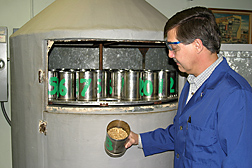Making a Better Barley for Brewing
Heat-friendly enzymes hold the key.
|
|
Some say there’s a science to appreciating fine beer. Such aficionados are meticulous about how they pour their beer, what kind of glass they use, and which foods they pair with a pilsner, for instance, versus an ale.
But the real science behind a glass of good brew starts with the quality of the barley kernels used to make it. It’s this grain’s abundant and complex starches that are broken down into fermentable sugars during the beer-making process.
Scientists in ARS’s Cereal Crops Research Unit at Madison, Wisconsin, are constantly scrutinizing barley kernels to find those with the best malting qualities. Not only is high-quality malting barley needed for brewing beer, it’s also important for producing many bakery goods and breakfast cereals.
Cynthia Henson, a plant physiologist at the Madison laboratory, and her colleagues have recently discovered superior barley enzymes that should make malting more efficient—yielding up to 30 percent more sugars than conventional enzymes. More sugar means more fermentable product for brewing—and potentially more for ethanol production, as well.
This discovery should please barley growers, who earn up to a dollar more per bushel for the grain when it meets or exceeds industry expectations. The more malting-friendly barleys should also be a boon to breweries and beer-related businesses, which contributed around $160 billion to the economy last year.
Taking the Heat
Cold, crisp, and refreshing—that’s how beer is often marketed. But the beer-making process is anything but invigorating: Extreme heat and dry, parching air are as vital to brewing as barley and water.
Before brewing can begin, barley kernels must be “malted.” Malting begins with steeping the kernels in water until the seeds begin to sprout, or germinate. This process helps cue production of enzymes that are crucial for turning starch into sugar. In nature, the young seed needs this sugar for energy to grow. In malting, brewers need it for fermentation.
But this manipulated growth spurt must be carefully controlled. About the time rootlets can be seen sprouting from the seeds, the kernels are blown dry in a 120˚F kiln to halt any further maturing in the seed. Soon after, the barley kernels are thrust into the heat again, where they’re roasted at temperatures of 175˚F or more, depending on the degree of malting—light or dark—desired.
So while heat is needed to complete the malting process, too much heat is destructive.
“Two of barley’s starch-degrading enzymes are heat-sensitive,” says Henson. “One of those is the second-most-important enzyme for converting starches into fermentable sugars.”
Called alpha-glucosidase, this enzyme screeches to a halt when it’s super heated. “At high temperatures,” says Henson, “alpha-glucosidase has less than 5 percent the activity it normally would.”
So Henson and others set out to find barley enzymes that could withstand the high heat imposed by malting. They went to nature for inspiration, assessing sugar beet, spinach, and even the model plant Arabidopsis for their thermostability.
Sugar beet proved to have the most impressive heat tolerance, so Henson and colleagues built a new barley enzyme with sugar beet as a model. They endowed their barley enzyme with a pivotal amino acid—the one that gives sugar beet its thermal edge.
By shuffling around other of the enzyme’s amino acids, the researchers have created three different heat-stable barley enzymes. All three have been patented.
Finding a Match in Nature
“Because there’s variation in the heat tolerance of plant enzymes across nature,” says Henson, “we’re screening a core group of barley accessions held in the ARS National Small Grains Collection in Aberdeen, Idaho.”
They hope to find cultivars with natural variations that are identical to the mutations designed in the laboratory. In other words, they’re using their patented enzymes as a search tool.
“We’re also looking for variation in another barley enzyme, called beta-amylase,” says Henson. “We’re looking for differences in the enzymatic activities of various malting and feed barleys.”
As it turns out, a barley cultivar that’s now being fed to livestock could very well hold the key to developing additional heat-stable enzymes.
Once barleys containing all-natural, heat-friendly enzymes can be found in the vast ARS collection, they can then be crossed with other proven cultivars to develop what might be considered the ultimate malting barley.—By Erin K. Peabody, Agricultural Research Service Information Staff.
This research is part of Plant Biological and Molecular Processes, an ARS National Program (#302) described on the World Wide Web at www.nps.ars.usda.gov.
Cynthia A. Henson is in the USDA-ARS Cereal Crops Research Unit, 1575 Linden Dr., Madison, WI 53706; phone (608) 262-0377, fax (608) 264-5242.
|
|
Calling All Barleys
The barley in your breakfast cereal or mug of beer didn’t arrive there by accident. The particular variety was likely carefully chosen by a breeder, brewer, or maltster based on information provided by ARS’s Cereal Crops Research Unit, in Madison, Wisconsin.
That’s because scientists there are not only conducting basic barley research, they’re also working at the only laboratory in the country that evaluates barley’s malt quality as a service for breeders and the malting and brewing industries.
Allen Budde, an ARS plant physiologist, heads up the unit’s malt-quality evaluation laboratory. There, he assesses how various barley selections perform—from kernel to malted product. Just last year, the laboratory’s researchers and technicians helped scrutinize more than 5,000 lines of barley—looking at such qualities as kernel plumpness, protein content, and enzyme levels.
These characteristics can all affect the brewing process. For instance, “a plumper kernel generally contains more starch that can be converted into sugars,” says Budde. Enzymes, nature’s chemical catalysts, are the components in the barley seed that break down those starches and turn them into sugars. But an excess of them, says Budde, can make the process “too hot” and hard for brewers to control.
Brewers and maltsters can avoid costly mistakes by having access to this evaluation data early on. And knowing which varieties are most commercially acceptable puts farmers in a much better position to get top dollar for their crop.—By Erin K. Peabody, Agricultural Research Service Information Staff.
"Making a Better Barley for Brewing" was published in the September 2006 issue of Agricultural Research magazine.








